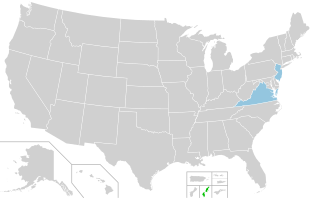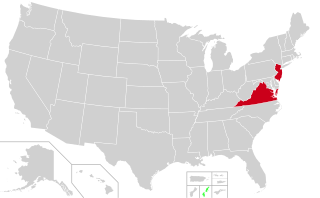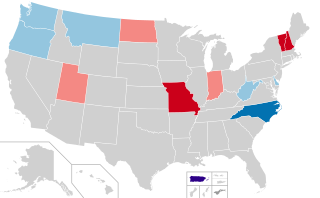
Richard James Codey is an American politician who served as the 53rd governor of New Jersey from 2004 to 2006. A member of the Democratic Party, he has served in the New Jersey Senate since 1982 and served as the President of the Senate from 2002 to 2010. He represents the 27th Legislative District, which covers the western portions of Essex County and the southeastern portion of Morris County. Codey is the longest-serving state legislator in New Jersey history, having served in the New Jersey Legislature continuously since January 8, 1974. He has served as the Deputy Senate President Pro Tem since 2022. In August 2023, Codey announced that he would not seek re-election and would retire from the state senate when his term ends in January 2024, having served for 50 years in the legislature.
John Orus Bennett III is an American former politician from New Jersey. A member of the Republican Party, he served as a state senator, and between 2002 and 2004, as president of the state senate. Bennett served as acting governor of New Jersey for four days in January 2002.
An acting governor is a person who acts in the role of governor. In Commonwealth jurisdictions where the governor is a vice-regal position, the role of "acting governor" may be filled by a lieutenant governor or an administrator.

United States gubernatorial elections were held on November 2, 2004, in 11 states and two territories. There was no net gain in seats for either party, as Democrats picked up an open seat in Montana while defeating incumbent Craig Benson in New Hampshire, while Republicans defeated incumbent Joe Kernan in Indiana and won Missouri after Bob Holden lost in the primary. These elections coincided with the presidential election.
Douglas Robert Forrester is an American businessman and politician from New Jersey. He was the Republican nominee for U.S. Senator from New Jersey in 2002, and the Republican nominee for Governor of New Jersey in 2005. Forrester was defeated by his two Democratic opponents, Frank Lautenberg and then-U.S. Senator Jon Corzine, respectively. Forrester currently serves as the president of Integrity Health, a health benefits management firm.

The 2005 Virginia gubernatorial election was held on November 8, 2005 to elect the Governor of Virginia. The Democratic nominee, Lieutenant Governor Tim Kaine, the son-in-law to Linwood Holton, won the election. Virginia is the only state in the United States to prohibit governors from serving successive terms, meaning that the popular incumbent, Mark Warner, could not run for reelection.

The 2005 New Jersey gubernatorial election was a race to determine the Governor of New Jersey. It was held on November 8, 2005. Democratic Governor Richard Codey, who replaced Governor Jim McGreevey in 2004 after his resignation, did not run for election for a full term of office.

The 2005 United States elections were held on Tuesday, November 8. During this off-year election, the only seats up for election in the United States Congress were special elections held throughout the year. None of these congressional seats changed party hands. There were also two gubernatorial races, state legislative elections in two states, numerous citizen initiatives, mayoral races in several major cities, and a variety of local offices on the ballot.
The lieutenant governor of New Jersey is an elected constitutional officer in the executive branch of the state government of New Jersey in the United States. The lieutenant governor is the second highest-ranking official in the state government and is elected concurrently on a ticket with the governor for a four-year term. The position itself does not carry any powers or duties other than to be next in the order of succession, but the state constitution requires that the lieutenant governor also be appointed to serve as the head of a cabinet-level department or administrative agency within the governor's administration, other than the position of Attorney General.

United States gubernatorial elections were held on November 6, 2001, in two states and one territory, as well as other statewide offices and members of state legislatures.

United States gubernatorial elections were held on November 3, 2009, in the states of New Jersey and Virginia, as well as in the U.S. commonwealth of the Northern Mariana Islands on November 7, 2009. Both state governorships were previously held by Democrats elected in 2005, and both were won by Republicans in 2009; the local Covenant Party maintained control of the governorship of the Marianas. These elections formed part of the 2009 United States elections. As of 2023, this is the last election after which the Democratic party held a majority of governorships.

The 2001 New Jersey gubernatorial election was a race for the Governor of New Jersey. It was held on November 6, 2001. Primaries took place on June 25. Democratic nominee Jim McGreevey won the general election with 56% of the vote — the first majority-elected governor since James Florio in 1989. His Republican opponent in that race was Bret Schundler.

The 2009 New Jersey gubernatorial election took place on November 3, 2009. Incumbent Democratic Governor Jon Corzine ran for a second term against Republican Chris Christie, Independent Christopher Daggett, and nine others, in addition to several write-in candidates. Christie won the election, with about 48.5 percent of the vote, to 44.9 percent for Corzine and 5.8 percent for Daggett. He assumed office on January 19, 2010. This was the first election to fill the newly created office of lieutenant governor, with the candidates for governor choosing their running mates. Kim Guadagno, Christie's running mate, became New Jersey's first lieutenant governor following her inauguration.

Persons 18 years or older on the general election date were eligible to register and vote in the general election. The following offices were up for election in the United States State of New Jersey in the general election on November 3, 2009:

Elections in Virginia are authorized under Article I of the Virginia State Constitution, sections 5–6, and Article V which establishes elections for the state level officers, cabinet, and legislature. Article VII section 4 establishes the election of county-level officers.

United States gubernatorial elections were held on November 5, 2013 in New Jersey and Virginia. These elections formed part of the 2013 United States elections. Before the elections, both seats were held by Republicans. Republican incumbent Chris Christie won reelection in New Jersey, while in Virginia, Democrat Terry McAuliffe won the open seat held by term-limited Republican Bob McDonnell.

United States gubernatorial elections were held on November 8, 2016, in 12 states and two territories. The last regular gubernatorial elections for nine of the 12 states took place in 2012. The last gubernatorial elections for New Hampshire, Oregon, and Vermont took place in 2014, as Oregon held a special election due to the resignation of Governor John Kitzhaber, while the governors of New Hampshire and Vermont both serve two-year terms. The 2016 gubernatorial elections took place concurrently with several other federal, state, and local elections, including the presidential election, Senate, and House elections.

United States gubernatorial elections were held on November 7, 2017, in two states: Virginia and New Jersey. These elections formed part of the 2017 United States elections. The last regular gubernatorial elections for these two states were in 2013. Both incumbents were term-limited, so both seats were open. Democrats held the governorship in Virginia and picked up the governorship of New Jersey.

United States gubernatorial elections were held on November 3, 2020, in 11 states and two territories. The previous gubernatorial elections for this group of states took place in 2016, except in New Hampshire and Vermont where governors only serve two-year terms. These two states elected their current governors in 2018. Nine state governors ran for reelection and all nine won, while Democrat Steve Bullock of Montana could not run again due to term limits and Republican Gary Herbert of Utah decided to retire at the end of his term.

United States gubernatorial elections were held on November 2, 2021, in two states, New Jersey and Virginia, and a recall election was held in California on September 14. These elections form part of the 2021 United States elections. The last gubernatorial elections for New Jersey and Virginia were in 2017, and the last regular gubernatorial election for California was in 2018. Going into the elections, all three seats were held by Democrats.
























